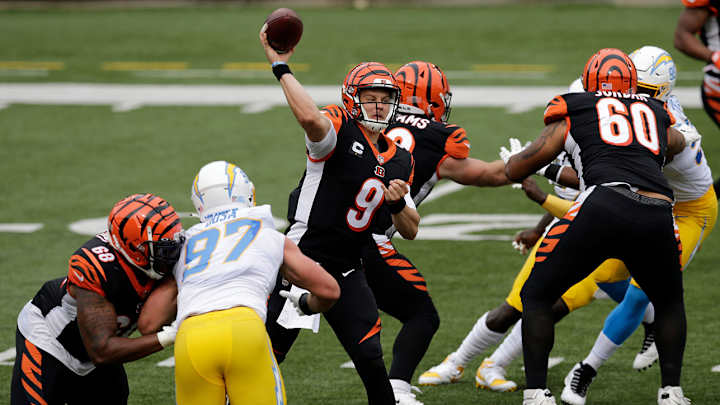Joe Burrow Looked Like a Good NFL Quarterback in his Week 1 Debut

On Joe Burrow’s second series in the NFL, on a first-and-10 from the Bengals’ own 20-yard line, he did something he was robotically familiar with at LSU.
From the shotgun, Burrow stuffed the ball into Joe Mixon’s chest as the two slid toward the line of scrimmage. All the while, he kept his eyes downfield, appearing to key in on Chargers safety Desmond King II. When King committed to the run, Burrow pulled the ball and threaded a dart to A.J. Green for a first down. It was an elemental RPO—run/pass option—play, a brilliant and wildly popular offensive fixture across the NCAA and the NFL that aided Burrow’s rise from unheralded transfer to top pick in the NFL draft.
At LSU in 2019, the Tigers ran a run/pass option more than once in every five plays (22.1%). They ran more run/pass options than about half the country. In doing so, they gained yardage at an almost unparalleled clip. Burrow completed more than 75% of his passes during his senior year and the Tigers gained an average of 10.8 yards every time he dropped back to pass. So it’s safe to say that the run/pass option was helpful to him (he was called, at various points during his senior season, “RPO JOE”).
But on Sunday, in his NFL debut, the play was one of what appeared to be a very small handful of true RPO plays the Bengals seemed to run. I could find five through a few spins on NFL Game Pass, though next to none that resulted in an actual throw. Pro Football Reference assigned 11 of Burrow’s 193 passing yards as coming from run/pass options and labeled three total RPO plays for the Bengals on Sunday.
The point being, Burrow is not totally being catered to. It’s not uncommon—especially now—for an NFL team to run a heavily-blended version of a quarterback’s collegiate offense. Even now, in places like Houston, we are seeing the team revisit some of the more central portions of Deshaun Watson’s scheme at Clemson. (Side note: Please do not interpret this as a criticism or think I’m suggesting Houston’s offense, or Watson, are gimmicky. Watson is and would be great in any system.) Burrow learned a new offense during a pandemic and started his first game, the only rookie quarterback to do so. And, despite some obvious mistakes, he looked good. The future is bright in Cincinnati.
From an analytical perspective, against a superior Chargers defense, saddled with a developing offensive line, Burrow was one of the better quarterbacks in football this past weekend (especially considering that he was pressured on 20% of his dropbacks, almost once per possession). His expected completion percentage differential was a positive 2.7, meaning he completed about 3% more of his throws than he should have. For perspective, 15 quarterbacks finished with a negative differential Sunday, with the biggest outlier being Washington’s Dwayne Haskins, who completed 12.4% fewer passes than he should have.
In terms of actual bad throws, like the early third-down miss intended for Mike Thomas and a pair of deep shots to A.J. Green and John Ross, Burrow was in line with projections. (The color analyst, former quarterback Trent Green, quickly blamed the Ross one on the receiver, though a tougher grader might suggest the ball needed to have a little less gas on it.) His bad throw percentage was 20, which was 5% better than Josh Allen’s season average in 2018, 2% better than Tom Brady’s percentage against the Saints on Sunday and 13% better than Haskins’s against the Eagles.
From an anecdotal perspective, the final drive was just about perfect. Burrow showcased his mobility on a version of the draw play on which he scored earlier in the game. He completed a handful of tight window throws at the sticks amid a no-huddle situation. He beat some difficult bracket coverage. He did not ignore receivers who had dropped balls to lean more heavily on reliable targets. And, on a smaller scale, he seemed to mix his cadences well, coming close to drawing the Chargers offside multiple times.
In essence, he did a little bit of everything that all good quarterbacks do, and not just a bunch of the same things he did to make it to this level in the first place.

Conor Orr is a senior writer for Sports Illustrated, where he covers the NFL and cohosts the MMQB Podcast. Orr has been covering the NFL for more than a decade and is a member of the Pro Football Writers of America. His work has been published in The Best American Sports Writing book series and he previously worked for The Newark Star-Ledger and NFL Media. Orr is an avid runner and youth sports coach who lives in New Jersey with his wife, two children and a loving terrier named Ernie.
Follow ConorOrr